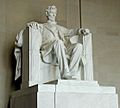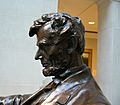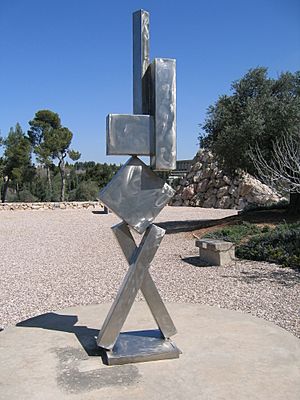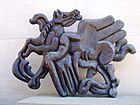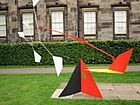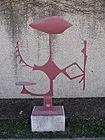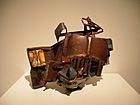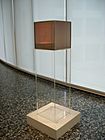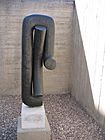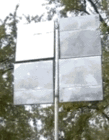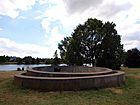Sculpture of the United States facts for kids
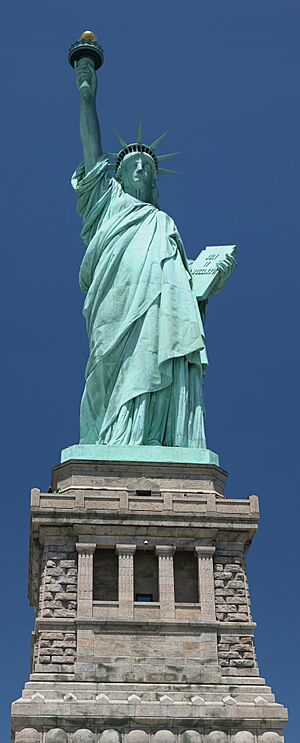
The history of sculpture in the United States started in the 1600s. Back then, skilled workers made simple carvings on things like gravestones, wooden boxes, and everyday objects. American sculpture has grown a lot since then. It has added many different styles and types of art to the world's cultural scene, right up to today.
Contents
- Early American Sculpture: Folk Art and Carvings
- Sculptors in Italy: The Neoclassic Style
- Women Sculptors in the 19th Century
- Studying in Paris: New Styles Emerge
- American Western Art
- Animal Sculptors (Animaliers)
- Public Monuments
- 20th Century Sculpture: New Ideas and Styles
- Modern Classicism: A Fresh Look at Old Styles
- American Expressionism: Carving with Feeling
- African-American Sculptors: A New Voice
- The Move to Abstraction
- Gallery of Modern American Sculpture
- Pushing the Boundaries of Art
- Minimalism: Simple Shapes and Forms
- Site-Specific Art: Art for a Place
- Postminimalism: Beyond Simple Forms
- Late 20th Century: Figures Return
- Other Kinds of Sculpture
- Legal Issues with Photographs of Sculpture
- See also
Early American Sculpture: Folk Art and Carvings
Sometimes, art can be found in everyday items. This includes well-made gravestones, iron goods, furniture, toys, and tools. These items often show more about a group of people than fancy sculptures made for rich families.
One special type of early American carving was making wooden figures for the front of ships. This started around 1750. A hundred years later, it helped artists like Samuel McIntire and William Rush (1756–1833) become famous. William Rush was one of the first well-known sculptors in the country. This tradition continues today in a style called Chainsaw carving.
Sculptors in Italy: The Neoclassic Style
In the 1830s, the first important American sculptors traveled to Italy. They lived and studied in cities like Florence and Rome. There, they created art in the Neoclassic style. Italy was a great place for them because it had many ancient artworks and museums to study. It also had skilled carvers who could turn their clay models into marble sculptures.
During this time, sculptors often chose themes from ancient Greek and Roman history. The only exceptions were portraits, where people often wore Roman or Greek clothes, or artworks that included Native Americans. Famous artists from this period include Horatio Greenough (1805–1852), Hiram Powers (1805–1873), Thomas Crawford (1814–1857), Thomas Ball (1819–1911), and Harriet Hosmer (1830–1908).
Women Sculptors in the 19th Century
Even though it was a time when women faced many challenges, American women also became active sculptors during the "Italian Period." Some of these women became very famous and received many orders for their art. These talented artists included Edmonia Lewis, Harriet Hosmer, Anne Whitney, Vinnie Ream, and Emma Stebbins.
-
Harriet Hosmer's Zenobia in chains, 1857.
-
Vinnie Ream's sculpture of Abraham Lincoln.
Studying in Paris: New Styles Emerge
After the American Civil War, more and more American sculptors went to Paris, France, to study. They learned a more natural and dramatic style from French artists like Jean-Baptiste Carpeaux and Antoine-Louis Barye. Some of the American artists who studied in Paris were Augustus Saint-Gaudens, Frederick MacMonnies, and Daniel Chester French.
-
The Adams Memorial, made in 1891 by Augustus Saint-Gaudens.
-
The Abraham Lincoln sculpture at the Lincoln Memorial in Washington, D.C., made in 1920 by Daniel Chester French.
American Western Art
In the mid-to-late 1800s, American sculpture was often classical and romantic. But it also showed a special interest in realistic, storytelling art, especially for themes about the nation. An example is the frontier life shown in the works of Frederic Remington. This was the start of "Western Art," a style that continued through the 20th and 21st centuries with artists like Alexander Phimister Proctor.
-
The Broncho Buster by Frederic Remington.
Animal Sculptors (Animaliers)
The realistic style of French artists, like Antoine-Louis Barye, greatly influenced the first American sculptors who focused on wildlife. These early American animaliers (artists who sculpt animals) included Edward Kemeys, Edward Clark Potter, Alexander Phimister Proctor, Charles Marion Russell, and Anna Hyatt Huntington.
Public Monuments
After the American Civil War, many more public monuments were built in the United States. Most of these monuments showed a soldier from the Civil War in a realistic pose. This style became popular thanks to sculptor Martin Milmore, who created one of the first such monuments in 1868.
As the 19th century ended, more monuments were built in big Eastern cities, especially to remember the Civil War. Many great sculptors emerged, most of whom had trained in Paris. Daniel Chester French was one of the most important, along with Frederick William Macmonnies and Lorado Taft. This tradition continued until the 1940s. Even today, sculptures of figures are used in public monuments. However, after the mid-20th century, public sculptures became more abstract.
After World War II, many monuments and memorials were built to honor the victims of the Holocaust.
-
A Civil War monument by Martin Milmore in York, Pennsylvania, 1872.
-
The Robert Gould Shaw Memorial in Boston Common. It honors Shaw and the Afro-American 54th Massachusetts Volunteer Infantry.
-
The U.S. Marine Corps War Memorial in Arlington, Virginia, designed by Felix de Weldon in 1954.
-
A Marine at the Vietnam Veterans Memorial on July 4, 2002. The memorial was designed by Maya Lin.
Carving Mountains: Giant Sculptures
The United States has at least three huge sculptures carved into mountains. These are Mount Rushmore, Stone Mountain, and Crazy Horse Memorial.
Gutzon Borglum, a skilled sculptor, started the Mount Rushmore sculpture in the Black Hills of South Dakota. He had also created other public monuments. After his death, his son, Lincoln Borglum, finished the monument. It features the faces of four U.S. presidents.
Gutzon Borglum also began the Stone Mountain project in Georgia. However, he had disagreements with the people in charge. The monument was then continued by Augustus Lukeman, who died in 1935. Walker Hancock finished the memorial, which was completed in 1972.
The Crazy Horse Memorial is also in the Black Hills of South Dakota. It shows the Oglala Lakota warrior Crazy Horse riding a horse and pointing into the distance. Sculptor Korczak Ziolkowski started it in 1948. After his death, his wife, Ruth Ziolkowski, and several of their children continued the project. The face of Crazy Horse was completed in 1998.
-
Mount Rushmore National Monument. Sculptures of George Washington, Thomas Jefferson, Theodore Roosevelt, and Abraham Lincoln represent the first 150 years of American history.
Architectural Sculpture: Art on Buildings
In the late 1800s and early 1900s, many public buildings were designed to include sculpture. This was especially true for sculptures carved in relief (meaning they stick out from a flat surface). Artists like Karl Bitter, Lee Lawrie, Adolph Alexander Weinman, and Corrado Parducci created works in a simple, often storytelling style that fit these buildings. Much of this work was done by unnamed sculptors and carvers.
-
North America, on Philadelphia City Hall, sculpted by Alexander Milne Calder in the 1870s.
-
Lincoln issuing the Emancipation Proclamation, on the Nebraska State Capitol, sculpted by Lee Lawrie around 1925.
-
Cane Cutter, on the Louisiana State Capitol, sculpted by Lee Lawrie in 1929.
-
River Traffic, on the Kansas City City Hall, sculpted by Walker Hancock in 1937.
20th Century Sculpture: New Ideas and Styles
As the 20th century began, many young European sculptors moved to the United States. The American economy was growing, offering new opportunities. Many important sculptures made before 1950 were created by these European-trained artists. They included Elie Nadelman, Albin Polasek, Gaston Lachaise, and Carl Milles.
Modern Classicism: A Fresh Look at Old Styles
Some American sculptors helped bring back the classical style during this time. A key artist was Paul Manship. He discovered ancient Greek sculpture while studying in Rome. C. Paul Jennewein and Edward McCartan were also important in this movement. Their work fit well with the popular Art Deco style of the 1920s.
In the 1930s and 1940s, different groups of American sculptors formed. One group, mostly American-born and favoring the older classical style, founded the National Sculpture Society. This group was led by the artist Anna Hyatt Huntington. Her work is preserved in Brookgreen Gardens in South Carolina, a sculpture park she created.
-
Paul Manship's Duck Girl, 1916.
American Expressionism: Carving with Feeling
Another group, often made up of immigrant artists, focused on a style called Expressionism. This group was the New York-based Sculptors Guild. They focused on more current themes and often used a method called direct carving in wood or stone. William Zorach was one of their well-known members.
African-American Sculptors: A New Voice
During the Harlem Renaissance, a new style of African-American sculpture appeared. Richmond Barthé was an excellent example of this. Augusta Savage was both a sculptor and a teacher. Richard Hunt was the first African-American sculptor to have a major show at the Museum of Modern Art in 1971. Other important contemporary sculptors include Elizabeth Catlett, Martin Puryear, and Thaddeus Mosley.
The Move to Abstraction
Some American artists, like Isamu Noguchi, had already started moving from realistic figures to abstract designs. But after 1950, American art changed dramatically. The U.S. led the world in a new, more experimental way of looking at modern art.
Within ten years, traditional sculpture training was mostly replaced by a focus on abstract design. Famous abstract sculptors like David Smith emerged. Artists also started using many new materials for their sculptures. Louise Nevelson was a pioneer in a new type of art called environmental sculpture.
However, some American sculptors continued to create works in their modern/classical style from before the war. These included Milton Horn and Charles Umlauf.
Gallery of Modern American Sculpture
-
Jacob Epstein (1880-1959), Day and Night, 1928.
-
Jacques Lipchitz (1891-1973), Birth of the Muses, (1944-1950).
-
Alexander Calder (1898-1976), L'empennage (1953).
-
Tony Smith (1912-1980), Free Ride, 1962.
-
Isamu Noguchi (1904-1988), Heimar, 1968.
-
Donald Judd (1928-1994), Untitled 1977.
-
Richard Serra (born 1939), Fulcrum 1987.
Pushing the Boundaries of Art
In the 1960s, human figures returned to sculpture, but not in the old classical style. Sometimes, artists like George Segal made life-sized figures using plaster casts. Jim Gary created realistic figures from metal washers and hardware, or even from stained glass and old car parts.
Artists continued to explore shapes and designs, but often without showing human figures. Minimalist sculptures by artists like Richard Serra and Norman Carlberg often took the place of figures in public spaces. Sculpture in the late 20th century became a fun way to explore what could be called art.
Minimalism: Simple Shapes and Forms
The Minimalist style makes sculpture very simple, focusing on its basic features. Minimalist artists include Tony Smith, Donald Judd, Robert Morris, Larry Bell, Anne Truitt, and Dan Flavin.
Site-Specific Art: Art for a Place
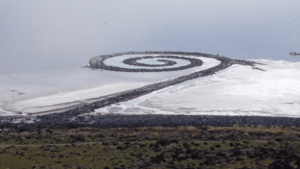
Site-specific art and environmental art are types of art made for a specific location. Artists like Donald Judd, Dennis Oppenheim, Richard Serra, and Christo and Jeanne-Claude led abstract sculpture in new directions. Artists created large-scale environmental sculpture works, sometimes called 'land art' or 'earth art,' in places like the American West. Famous examples include works by Robert Smithson and Michael Heizer.
Postminimalism: Beyond Simple Forms
Artists like Bill Bollinger, Eva Hesse, Sol LeWitt, Jackie Winsor, and Bruce Nauman were pioneers of Postminimalist sculpture. The later works of Robert Graham continued to develop, often in public art settings, into the 21st century.
During the 1960s and 1970s, artists explored new ways of using abstraction, images, and figures. They used Light sculpture, Land art, and installation art.
Late 20th Century: Figures Return
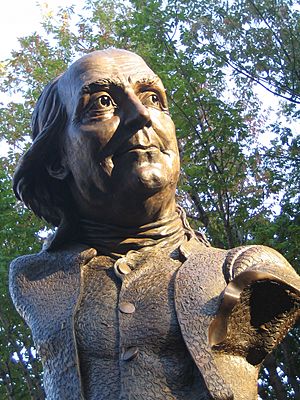
Other types of sculpture also became important. Some grew from the work of iron artists in the early 1900s, like Samuel Yellin. A center for Western-style American sculpture grew in Loveland, Colorado. Many studios, magazines, and even a museum (the National Cowboy & Western Heritage Museum) focused on this interest. A new Victorian-inspired style also appeared, started by sculptor Frederick Hart.
Other Kinds of Sculpture
The art-doll and ceramic sculpture communities also grew in the late 20th century. The entertainment industry also needed large, amazing sculptures for movie sets, theme parks, casinos, and sports stadiums. Industrial product design, especially for cars, is another area where sculpture plays a role. For example, Randolph Parducci created sculptures for the famous chariot race scene in the movie Ben Hur.
Legal Issues with Photographs of Sculpture
In the United States, courts have said that sculptors keep their intellectual property rights to their sculptures. This means they should be paid if photos of their sculptures are used for business purposes. These rights apply even if the sculptor no longer owns the sculpture or if it's in a public place. However, a sculptor can sign away these rights. Some other countries, like Germany, allow photos to be taken freely under a rule called Panoramafreiheit, or Freedom of Panorama.
On February 25, 2010, a court ruled that Frank Gaylord, the sculptor of the Korean War Veterans Memorial, should be paid. This was because an image of his sculpture was used on a 37-cent U. S. postage stamp. He had not given up his intellectual property rights.
In 2002, a photographer was paid $1,500 to use his photo of the memorial on a snowy day for the stamp. The stamp sold more than $17 million worth of stamps. In 2006, Frank Gaylord claimed that the U. S. Postal Service had used his sculpture without permission. The Postal Service argued that Gaylord was not the only sculptor and that the sculpture was actually part of the building. Gaylord won most of his arguments. The court first said the photo was fair use, meaning he wasn't owed money. But Gaylord appealed this decision and won. On April 22, 2011, the United States Court of Claims awarded Gaylord $5,000.
See also















